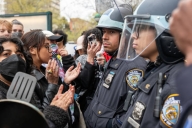You have /5 articles left.
Sign up for a free account or log in.
The death of the author has been a recurring theme in literary theory and philosophy at least since Roland Barthes’s seminal essay on the topic in the 1960s. The model for the critique of authorial control was the lone actor, the single producer unaware of the forces (assumptions, prejudices, historical accidents, etc.) that shape the production and reception of his or her work. It has remained largely a theoretical point: regardless of authority, authors of course continue to produce works under their names and, protected by commercial copyrights that began in the 16th century, enjoy royalties and professional recognition for their work.
The displacement of the author’s authority, however, is no longer solely a matter for theorists: it is now occurring concretely and practically through the flourishing of crowdsourced, collaborative productions of content. While there have long been instances of it commercially (consider, for example, white papers whose only authorial attribution is the corporate name), there is no greater expression of this development than openly licensed educational content.
Unlike scholarship or research publications, educational content is meant to be decidedly unoriginal: it is a survey of the state of a field, intended to introduce students to generally accepted principles, ideas and research findings. The extent to which information is original, and therefore not generally accepted in the field, renders it susceptible to excision in a survey course. Learning materials, then, are reflections of a community of practice, captured at a moment in the history of a discipline. As such, producing them is inherently a social, community-based exercise.
Viewed in this way, the commercially copyrighted model of educational content production can look like an historical anomaly. The collective effort at constituting a body of knowledge appears printed and bound or digitally distributed with a nameplate, and often a “brand” name (sometimes even representing people who are no longer living), obscuring the social character of the work.
To be sure, this is not to leave unacknowledged the considerable effort writers of educational content put into their work, spending years organizing and synthesizing these surveys into forms that meet faculty learning objectives. Such work, of course, deserves to be recognized professionally and financially. Doing so, however, is quite a different matter than regarding the survey itself as an original contribution of a single author or group of authors. The concepts, for example, of anomie and of ideal types are central for an introduction to sociology, but these emerged from the works of, respectively, Durkheim and Weber, not the textbook author.
Rarely are the concepts described in an educational text the author’s own. Like a gardener, the textbook author cultivates and shapes those elements that already exist and that are well established -- elements that many faculty adopters often would prefer to see adjusted, moved or rearticulated.
This assembler and synthesizer role requires recognition professionally and financially -- it’s the chief motivation for most writers to prefer traditional publishing -- but the maturing models of openness achieve this, too, without the encumbrances of the commercial copyright, through delivery platform revenue sharing, foundation support and other channels (and it’s only just getting started). What’s more, open models mean that far more faculty can be recognized professionally and financially as authors, editors and revisers of educational materials. Rather than a pyramid in which only those at the top enjoy the benefits of such recognition, open models can distribute resources across a wide range of participants, the value of which is dependent less on the author’s “brand” than on what the individual contributors achieve. They have the capacity, then, to unleash levels of creativity and innovation that would be unthinkable in the closed commercial world.
Within the publishing houses themselves, the notion of educational materials as the work of a single author or group is also becoming less tenable, as textbooks yield to digital courseware that merges textual content and interactive technologies and give faculty adopters some control over how the learning objects are delivered to their students. Commercial courseware is produced in the corporate world, then, much like a white paper is: with the authorial control of an organization rather than of an individual.
If, however, the underlying content is meant to be a representation of the state of a field, is it not best produced and shared by that community in a way that is as unfettered and collaborative as possible, recognizing that faculty in the field also wish to have a say on how that content is articulated and conveyed? And is the daunting task of producing a textbook or similar work more daunting because, as a commercially closed process, it has little recourse to the community of educators as participants?
What’s exciting about the emerging model for openly licensed educational content is its appeal to pedagogical inclusivity, that it aligns more effectively than commercially produced materials with the way disciplinary knowledge is shared in the academy. Open models of collaboration map digitally to the way faculty and students discuss the subjects, in faculty training and in the classroom.
In the sharing of educational knowledge, the decline of the author bodes well for learning. The prejudices, influences and assumptions that a single author carries into their work can now be evaluated, tested and challenged through an open process that was unthinkable in Barthes’s world of the solitary writer. Thanks to open models, the binary opposition of author and reader is breaking down. Faculty and students are no longer passive recipients of someone else’s synthesis -- the commodity with which one is presented -- but participants in it as a living work.
Openness, then, is about the renewal of educational engagement for faculty and students. Coming at a time when few assumptions about the academy can go unchallenged, it is a powerful and radical way to reimagine the relationships of teacher, student and text.








